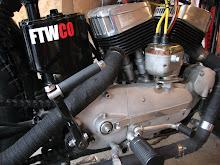I've been jammin' the last few weeks to get this WR engine done so I can deliver it to
The Mama Tried Motorcycle Show on Feb. 15-16 in Milwaukee. This particular engine has some documented race history with a top 5 finish in the early 1950s at the legendary Springfield Mile.
After repairing the engine cases, machining, measuring, etc. Almost every part on the engine has required attention. The motor was together when I received it, but the parts mirrored "swap meet specials" haphazardly assembled. The ball bearing construction appears easy to conquer...but now you're dealing with hand-press-fit on everything. It's very difficult to align the cam timing marks when each cam is pressed into position. I ended up "adding the pinion gear last" since it's slip fit, and the wide mark on the spline is at the same position as the timing mark, so you knew your position. So many particulars need addressed when assembling an engine of this nature. Basically, it's got to be perfect, or destroy shit on initial start up. This is the
5th ball bearing-type engine I've built (with dad too) - and we still spend about as much time reading, as we do building the motor.
The magneto is a horizontally mounted Wico Single Fire type unit. The ignition timing is best set by
location of the piston to TDC...then verify the timing actual timing mark on the flywheel. On the earlier WRs, once the gear cover is on...you can't change your timing from the outside, since the magneto is bolted solid to the case. No rotation. The Wico cap has a #1 which indicates the REAR(or #1 cylinder) and the spark plug wires must be installed correctly.
I updated the sprocket shaft seal (from the steel reverse thread seal) to a modern type rubber-lip seal. It required indicating the oem steel outside spacer to dead on a lathe, then turning a recess for the seal (for press fitment)and cutting a snap ring groove. The seal kit (from Colony) is the same as a Big Twin seal, since the sprocket shaft in a WR is the same diameter as a panhead....but instead, runs a large 25mm ID high load ball bearing. A
#1205 ball bearing to be exact: 25mm x 52mm x 15mm Superblend-type bearing. This type bearing compensates for crankshaft deflection.
The pinion side runs a #1204 Superblend type bearing.
20mm x 47mm x 14mm
All bearings require light press fit on shafts and case.
It's just fun times getting all this to fit the way it should...

The lower pump has been checked over, blasted, washed and inspected. I painted it my special cast iron gray, installed, with breather timed. I bumped the breather ahead 1 tooth, since the piston was already about 2" down in the cylinder before it started opening (via breather timing mark). By one tooth advanced, the breather window opens just after TDC - to get that crankcase evacuated of pressurized air a bit sooner. The cylinders had "hardened steel sleeves" installed sometime over the years. I had to purchase specific honing stones to straighten-out-the-tight-spots and generate a usable set of cylinders, since they are already oversized. To win races back in the 1950s, these engine builders used the largest valves, and largest bore sizes, and bent the rules to take wins. Unfortunately, the removal of all this metal leaves nothing behind for restoration. New guides, a couple valves, new springs, all shimmed and set for cam specifications. The cylinder/valve work on these flatheads is usually the most time consuming. It seems simple, but these motors will run and run while still way-out-of-specification. They're usually worn to epic levels. These things just keep on chugging - all the way to the flag !
































































